Erica Vetsch's Blog, page 130
August 28, 2018
Relationship, Relationship, Relationship!
By Guest Authors from Mountain Brook Ink
Mountain Brook Ink publishing focuses on reader relationships and stories of restoration and renewal. We asked some of our authors to share how they connect relationships: relationships between plot and setting, message and story, and author and reader. Here’s what they had to say:
 Kimberly Rose Johnson (The Sleuth’s Miscalculation): Importance of Setting
Kimberly Rose Johnson (The Sleuth’s Miscalculation): Importance of SettingSetting is as important to a story as the characters and the plot. I often choose small towns in which to set my stories, but sometimes the plot requires a city. For example, my book The Reluctant Groom is a modern day marriage of convenience story set in the more believable environment of big city Seattle.
But there is no way The Sleuth’s Miscalculation would work in a big city. The plot revolves around a small town librarian who enjoys solving mysteries and consults for the Sheriff’s Department for non-violent crimes. This story begged to be set in a small town with all the familiar quirks that go with small town life.
Let’s look at settings on television shows. Can you think of an example of where setting was critical to the story? Can you imagine Magnum P.I. being set anyplace but Hawaii, or Castle anyplace but New York City? Those settings enhanced their stories; our settings enhance our books.
In my process, setting is one of the first factors I determine. The very first series I sold was actually based on the setting, and I wrote the story around it. I hope this has encouraged you to have fun with setting and use it to enhance your next project.
 Angela Ruth Strong (RESORT TO LOVE series): Power of Setting
Angela Ruth Strong (RESORT TO LOVE series): Power of SettingThe novel that kickstarted my career was released as part of the Love Finds You line. I held Costco book-signings, received a hardback edition, and had the novel optioned for film. But the most important thing I learned? The power of setting.
In researching for Finding Love in Sun Valley, Idaho , my best friend and I visited a famous lodge and I took my kids white water rafting. Later, my husband and I decided to ride the motorcycle to Montana and also volunteer at the Sun Dance Film Festival in Utah. I learned things that I wouldn’t have known to add to my stories had I not experienced the location for myself.
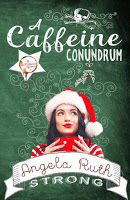 Pre-order: https://amzn.to/2PvOZWhI didn’t want to stop there though. I wanted to set authentic stories all over the world. So I got a job for an airline two years ago. Since then, I’ve hiked the mountains of Colorado, driven a convertible to Key West, attended my first MLB game in Arizona, watched the sun set in San Diego, etc.. My life has become as exciting as that of my characters.
Pre-order: https://amzn.to/2PvOZWhI didn’t want to stop there though. I wanted to set authentic stories all over the world. So I got a job for an airline two years ago. Since then, I’ve hiked the mountains of Colorado, driven a convertible to Key West, attended my first MLB game in Arizona, watched the sun set in San Diego, etc.. My life has become as exciting as that of my characters.I may not dream fantasy worlds, but I’m so enamored with our world that I want to experience as much as possible. Either way, I find inspiration everywhere, and I believe my Resort to Love series is better for it.
 Book cover coming soon!Linda Thompson (The Plum Blooms in Winter): Melding Message with Story:
Book cover coming soon!Linda Thompson (The Plum Blooms in Winter): Melding Message with Story:I plot my books “inside out.” And I suspect I’m not alone.
A true story inspired my debut novel, The Plum Blooms in Winter . The aspect of the story that gripped me—its real power—was in the characters’ final epiphanies, their realization of a theme or revelation. But what kind of epiphanies will I portray in my stories?
For my first book, I naively intended the epiphanies to unfold as they happened in real life—while reading the Bible; while hearing a sermon. But that approach isn’t compelling enough for fiction. For a reader to “feel” the character’s epiphany—and have it rock their own world—it must be triggered by “an action and sensory details the reader can share.” (Janet Burroway, Writing Fiction: A Guide to Narrative Craft) Burroway supplies an example where an epiphany is sparked by the sight (and smell!) of a trout struggling in a net. Rich sensory details take the POV character back to a memory that triggers his realization and carries the reader in the current of that turning point.
How can you magnify an epiphany?
Engineer your character arc: Start your character with a flaw that places her far away from the point where she’ll end up.
Engineer your supporting cast: An array of characters with diverse perspectives can help you thoroughly examine the topic of your character’s epiphany, plus create tension and dimension. Consider Tolkien’s casts, and his theme: can everyday people accomplish enormous things?
 Taylor Bennett (Porch Swing Girl): Connecting with #Bookstagram
Taylor Bennett (Porch Swing Girl): Connecting with #BookstagramIt can seem like being an author is all about platform—that word is everywhere, from an agent’s submission guidelines to the ads popping up on your browser, shouting things like “Build a Bigger Platform Now!”
With all of this pressure to cultivate a group of rabid fans, it’s easy to make platform sound like a regulation, a requirement—something along the lines of “each submission must be double-spaced with 12 pt. Times New Roman font…”
BUT IT’S NOT.
Creating a platform can be an incredibly enjoyable and fulfilling experience for both the author and their group of readers. Take it from me—before I dreamt of being published, I had nothing more than a languishing Facebook account. Skeptical of social media in general, I was hesitant to start promoting myself (and my writing) on platforms such as Twitter, Pinterest, and Instagram.
But that changed.
I discovered the #bookstagram community, a vibrant group of readers and writers on Instagram. And no matter their diverse passions, they all share a common love: books. Their posts typically highlight a book they’ve read, a book they’re excited to read, or a book that touched their life while growing up.
In other words, this sweet, supportive community is an amazing place to market without actually marketing. By joining in the chatter about some of your favorite books, you can connect with fellow readers who might be interested in checking out your book, too.
It’s a win-win for everyone…and it’s tons of fun, too!
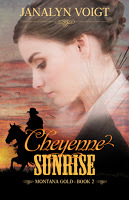 Janalyn Voigt (MONTANA GOLD series): Description and Connection
Janalyn Voigt (MONTANA GOLD series): Description and ConnectionReaders often mention that they felt like they actually visited my story worlds. While I love hearing that, it wasn’t always the case. I blush to recall receiving critiques scrawled with messages of a less heart-lifting nature. “Help! I’m drowning in detail.” “Nice description in the opening scene, but when does the story start?” “You don’t need to grandstand.”
Ouch.
I had a lot to learn. Grinding through edits has a way of polishing a writer. Working with editors is an apprenticeship that has taught me to write with more finesse.
Now, here’s what I don’t do when writing descriptions:
l Don’t start a story with scenery. Readers might admire the view, but they are more interested in connecting with your characters and engaging with the plot. l Build descriptions around your characters. Rather than going on about the waves at the beach, let your protagonist stand in the surf and watch them roll in. This provides immediacy and avoids stalling the story on descriptions. l Employ the senses but not as a litany. It’s not necessary to use all five, only the ones your viewpoint character would notice.l Use detail to sharpen the imagery. Use ‘oaks’ instead of ‘trees.’ Move closer. Show branches etched against the sky and shadows weaving on a mossy bank. l Don’t overwhelm with extraneous details, however. Give enough to paint the scene with light strokes and allow readers to imagine the rest. Let them make the story their own, and they will praise you for it.
What relationships are important to you as an author and/or as a reader?
***Missy here. Let's chat about relationships! And let us know if you'd like to be entered in the giveaway. Mountain Brook Ink would like to give away a print copy to one winner (U.S. only please) from one of these featured titles: Winner's choice between Finding Love in Sun Valley Idaho, The Sleuth's Miscalculation, Porch Swing Girl, or Hills of Nevermore.
****
Award winning author, Kimberly Rose Johnson, married her college sweetheart and lives in the Pacific Northwest. From a young child Kimberly has been an avid reader. That love of reading fostered a creative mind and led to her passion for writing. She especially loves romance and writes contemporary romance that warms the heart and feeds the soul. You can learn more about Kimberly at kimberlyrjohnson.com.
Angela Ruth Strong was first published by a national magazine while still in high school. She has won both Idaho Top Author and the Cascade Award for her novels, and she is the founder of IDAhope Writers. Besides writing, she teaches group fitness classes, travels with her kids on youth group mission trips, and often gets herself into silly situations like hamster ball races or riding on the shoulders of a unicyclist. You can learn more about Angela at angelaruthstrong.com.
Linda Thompson stepped away from a marketing career that spanned continents to write what she loves—stories of unstoppable faith. Her debut novel, The Plum Blooms in Winter, launches December 1. She lives in the sun-drenched Arizona desert with her husband, a third-generation airline pilot who doubles as her Chief Military Research Officer, two mostly-grown-up kids, and a small platoon of housecats. You can learn more about Linda at lthompsonbooks.com.
Taylor Bennett is an assistant editor for Magnum Opus Magazine. She has published several pieces of fiction and nonfiction in Magnum Opus Magazine and her novel, Porch Swing Girl, was a semi-finalist in the Go Teen Writers “We Write Books” contest. Taylor is a member of ACFW and OCW and she is active on Facebook, Twitter, Pinterest, and Instagram. You can learn more about Taylor at taylor--bennett.com.
Janalyn Voigt is a multi-genre novelist who has books available in the western historical romance and epic fantasy genres. Her unique blend of adventure, romance, suspense, and whimsy creates worlds of beauty and danger for readers. Janalyn is represented by Wordserve Literary and holds memberships in ACFW and Northwest Christian Writers Association. You can learn more about Janalyn at janalynvoigt.com.
Published on August 28, 2018 21:01
August 26, 2018
How to Survive A Pitch Appointment

It's time for a full confession.
I. Do. Not. Like. Pitching. There, I said it.
As a veteran of getting on for twenty writing conferences and many pitch appointments, I can say with some authority that I do not enjoy the process. I am awkward and nervous and tongue-tied to a ridiculous degree.
So why am I posting here on the intricacies of pitch appointments and how to excel at them?
Well, if you re-read the title of the post, you'll note that I'm not telling you how to hit a home run in a pitch appointment, I'm telling you how to SURVIVE one. :)

Follow me into the labyrinth, if you please.
First, what is a pitch appointment?
At writing conferences, you often have the opportunity to secure one-on-one appointments with mentors, agents, editors, and other industry professionals. This is your chance to talk about your work and yourself with a view to selling both at some later date.
For some of us, the idea of sitting down with an agent or editor and talking up our story is torturous. But it's a necessary part, and even a good part, of becoming a professional author. (There are a select few who THRIVE on these appointments, but they're the outliers, so we're going to ignore them. The weirdos.)
So, if pitch appointments are something we should do, and yet we don't like doing them, and they do, in fact, scare us, how can we strategize to at least survive them, even if we don't exactly THRIVE?
Here are my tips:

1) Do your research. There's nothing that will add to the awkwardness of a face-to-face pitch meeting than if you bring in something that the agent or editor isn't looking for, doesn't represent, and perhaps doesn't even like. Most conferences will have a website that lists the faculty, and in their bios, if they are taking appointments, they will list the things they are looking for, and the things they are not wanting to see. Don't assume that you've written such a heartbreaking work of staggering genius that the editor will abandon the entire publishing history of their house and champion your cause and yours alone at the next publication board meeting. Start out on a good note by scheduling pitch appointments with people who rep what you write.
2) Manage your expectations. This one is key. You are NOT going to walk out of a 15 minute appointment with a contract. These meetings are for getting your foot in the door, not for signing the mortgage and calling the movers . The hope from this meeting is that you will receive a request for a proposal, that you've interested the agent or editor enough in yourself and your project for them to want to see a bit more. HOWEVER, if you do not receive a proposal request, the meeting was NOT a failure. You will have learned a bunch, and your name and face will now be familiar to the person you pitched to, so that next time you see them or pitch to them, you've got a bit of a connection.
3) Prepare a One Sheet: I blogged about this last month, so no need to go over it again here. You can read about how to prepare a One Sheet HERE: https://seekerville.blogspot.com/2018/06/what-goes-on-one-sheet.html

4) Do your homework. (This isn't the same as doing you research.) This one requires that you practice your elevator pitch (We'll talk about how to write an elevator pitch a bit next month.) Doing your homework requires that you be able to distill your story down to 30-50 words. Who it is about, what they want, and the major conflict that is keeping them from getting what they want. This needs to be succinct, pithy, and interesting.
‘A police chief, with a phobia for open water, battles a gigantic shark with an appetite for swimmers and boat captains, in spite of a greedy town council who demands that the beach stay open .’
And there, ladies and gentlemen, you have the perfect elevator pitch. (JAWS: A very good book, but an even better movie!)
You need to know your story inside and out to be able to talk intelligently about it in a concise way. We can all ramble for days about our plot and characters, but I guarantee that if you do this in your pitch appointment, the agent or editor's eyes will glaze over and they will start wondering when it will be time for lunch.
Once you have your 30-50 word pitch written, you need to practice saying it aloud. Start alone, looking in the mirror, then try it out on your family or a writing buddy. Be able to speak slowly, succinctly, and coherently about your story and to be able to answer questions posed by the listener. You might think this is a dorky thing to do, but trust me, you'll thank me later.
5) Do a Quick Reconnaissance: When you get your pitch appointment info, do a quick recce and locate where the appointments are going to take place so you can find it again when you need to. The last thing you want as your meeting time approaches is to be wandering the halls of a giant hotel or conference center hollering "Marco!" Find out where they appointment desk is, where the "Kiss and Cry" area is. (That waiting room where folks about to go into an appointment sit and wipe nervous sweat, and where those just exiting appointments can gracefully subside into a chair and pray in thanksgiving that they survived....Just kidding, but there usually is a 'holding pen' sort of area near the appointment desk where writers are herded to patiently wait for their appointment.
6) Pray About It: Spend a little time in prayer beforehand, reminding God (and thus yourself) that your entire writing future does not hinge on the 10-15 minutes you will be with EditorX or AgentY. Also spend a little time praying for that agent or editor, and consider how you might be a blessing to them during that time. Thank the Lord for the opportunity, and then use it to the best of your ability.
So, what can you expect from your pitch appointment?
Get to the appointment desk with 10-15 minutes to spare, (make sure you've visited the facilities before you arrive, nerves and coffee, you know...) have your materials in order, and say a quick prayer. When your appointment time is called, you can expect to be ushered into a room with up to 20 different tables where pitches will be taking place simultaneous to yours. Don't let this daunt you, you won't be listening to other people pitch, and they won't be listening to you. Everything is done in quiet orderly fashion, not a free-for-all. Sit down across from the agent or editor and smile, offer your hand, and introduce yourself. Hand them your one-sheet. Remember that this is not their first rodeo, and give them a moment to scan your paper and perhaps ask you to tell them about your story. This is where you launch into your elevator pitch. Don't talk too fast, and try to have a pleasant expression on your face. Its' okay to be a bit nervous. They're used to that. As pros, they will often have a few pithy questions for you. I always find it easier to answer questions about my work than just talk about it off the cuff, so I welcome the questions. They may ask for a little of your writing background, what you've published before (It's okay if you're unpublished! Just say so!) and if the manuscript is complete or not.
When time is called, (it will go faster than you think!) stand, offer your hand again, and thank the agent or editor for his or her time. Don't start sobbing if they don't ask to see more of your work or if they return the one-sheet you labored over so long. Be gracious, and be kind.
Oh, and one more thing!

7) Follow Through Afterwards: If you've received a request for a proposal or full manuscript, then by all means, send it in! You don't have to hit send on the airplane ride back home, but do follow through and deliver what has been requested. A month or six weeks is a good time frame if you're polishing a proposal or manuscript. If you didn't receive a request for a proposal, it's still nice manners to send a thank-you note to that person for meeting with you. This will be remembered.
Q4U: Have you done any pitch appointments? What's the BEST pitch story you've heard? What's the WORST pitch appointment story you've heard. No names (unless it's yours and you don't mind sharing.) Also, do you LIKE pitch appointments? Or are you normal? LOL!
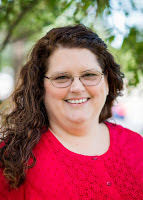 Best-selling, award-winning author Erica Vetsch loves Jesus, history, romance, and sports. She’s a transplanted Kansan now living in Minnesota, and she married her total opposite and soul mate! When she’s not writing fiction, she’s planning her next trip to a history museum and cheering on her Kansas Jayhawks and New Zealand All Blacks. You can connect with her at her website, www.ericavetsch.com where you can learn about her books and sign up for her newsletter, and you can find her online at https://www.facebook.com/EricaVetschAuthor/ where she spends way too much time!
Best-selling, award-winning author Erica Vetsch loves Jesus, history, romance, and sports. She’s a transplanted Kansan now living in Minnesota, and she married her total opposite and soul mate! When she’s not writing fiction, she’s planning her next trip to a history museum and cheering on her Kansas Jayhawks and New Zealand All Blacks. You can connect with her at her website, www.ericavetsch.com where you can learn about her books and sign up for her newsletter, and you can find her online at https://www.facebook.com/EricaVetschAuthor/ where she spends way too much time!
Published on August 26, 2018 21:00
August 24, 2018
Weekend Edition

If you are not familiar with our giveaway rules, take a minute to read them here. It keeps us all happy! All winners should send their name, address, and phone number to claim prizes. Note our new email address and please send your emails to Seekerville2@gmail.com

Monday: Jan Drexler talked about balancing your life and writing, and we shared a lot of great ideas! Be sure to read all the comments if you haven't already. Some of you Seeker-villagers had some wonderful ideas! And the winner of a copy of The Sound of Distant Thunder is Janet E. (Library Lady)!!! Congratulations!
Wednesday: Melanie Dickerson expounded what it means to Write Your Feelings, using examples from her new Southern Historical Romance, Magnolia Summer. The winner of a paperback copy of Magnolia Summer is Sandy Smith, and winner of an e-copy is Vince. Congrats!
Friday: Pam Hillman dusts off a post on Memes, Monkeys and Me: Photo Editing and Graphic Design for Amateurs which originally aired in Seekerville in 2013. At that time some of us didn't know what a meme was, and others thought it was pronounced memE (ahem). Who doesn't need a refresher on this timely topic??

Monday: Erica Vetsch will share How To Survive A Pitch Appointment. Come armed with your best (Or Worst) pitch appointment stories!
Wednesday: We'll be joined by guest authors from Mountain Brook Ink! Be sure to come by to hear from Linda Thompson (Historical Fiction), Taylor Bennett (Contemporary YA), Angela Ruth Strong (Contemporary Romance), Kimberly Rose Johnson (Romantic Mystery & Contemporary Romance) and Janalyn Voigt (Historical Romance). It should be a fun day! Friday: Erica is back with a brand new release! Put a little Christmas into your Back to School as we celebrate the release of the Victorian Christmas Brides Collection...and she's got a BIG, BIG Announcement, too! (And she'll open the prize vault for a giveaway or two!)
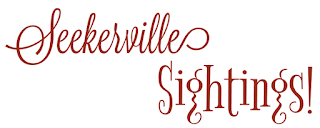
Jan Drexler's newest book, The Sound of Distant Thunder, book one in the new "Amish of Weaver's Creek" series, is available for pre-order now! The release date is September 18th!
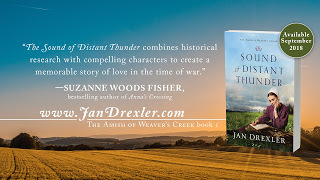 Available at Barnes & Noble, Amazon, and everywhere
Available at Barnes & Noble, Amazon, and everywheregreat books are sold. Head over to Jan's website for the links:
www.JanDrexler.com Ruthy's delightful novella collection, featuring the smokin' hot Greek Karralis cousins, Rafe, Jake and Dimi (Jim) is available for Kindle or paperback.... and it includes a wonderful novel based on Ruthy's Kirkwood Lake series with Love Inspired.... All four novellas, great romantic reads, for under three dollars! A great price... and great stories... makes this a win for everybody situation! Click Here to check it out on Amazon, my friends! And Ruthy's got ONE KINDLE COPY for a happy reader or writer.... but you have to tell her you want to be in the drawing because youse know she's busy pickin' pumpkins on the farm! :)

 Loving the Texas Lawman * Loving Her Texas Protector
Loving the Texas Lawman * Loving Her Texas ProtectorLoving the Texas Negotiator available for pre-order, coming in September
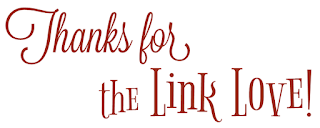
Are You In or Out? Crafting Outlines that Work for You by Janice Hardy at Fiction University
10 Successful Advertisers’ Tips for Targeting Readers with BookBub Ads by Carlyn Robertson from BookBub Partners blog
Why A Well-Written Novel Can Still Stink by Janice Hardy at Fiction University.
Authors Guild Comments to FTC on Internet Monopolies' Impact on Creators at The Authors Guild website.
Getting The Big Picture Across In Your Scenes by CS Lakin at Live Write Thrive
7 Ways To Beat Writer's Block by Michael at Daily Writing Tips
3 Ways To Search In Scrivener 3 by Gwen Hernandez at Writers In The Storm
Who's Going To Help Your Hero? by Jim Dempsey at Writer UnBoxed
The "Plot Your Novel" series by Sarra Cannon at HeartBreathings
3 Time Management Tips: Writing When You Have No Time by Angela Booth at Just Write a Book Blog
Published on August 24, 2018 21:00
August 23, 2018
Memes, Monkeys, and Me: Photo Editing and Graphics Design for Amateurs

by Pam Hillman
This post first appeared in Seekerville in 2013, and at the time some of us didn't know what a meme was, and others thought it was pronounced memE (ahem). Assuming some of us might need a refresher, let's start at the beginning.
What’s a meme? Our current society considers a meme as an image or video that is passed electronically from one internet user to another. All those cute little pictures with captions that we see on facebook and Pinterest? They’re memes. We’ll get to the monkeys in a minute, but first, my graphics design credentials.
I became an amateur graphics designer many, many years ago. And I do mean amateur. My first foray into design was of the cut-and-paste nature. A co-worker’s son was having his 3rd or 4th birthday party and his mother found cute action figure plates, cups, and napkins for the party. We designed invitations, cut out the action figure from one of the plates, and taped it to the invitation and made copies on a black and white copy machine. Hey, this was the dark ages, but the invitations were still cute as a button and his son loved them, so that was what counted.
One thing led to another, and I started a cottage business called Celebrations, DTP (desktop publishing). I created logos, business cards, and letterheads for small businesses. Since the internet was unheard of (yes, there was such a time), I ordered font packages, clip art, and software to install on my computer. I also begged the local newspaper for all their old clipart books that they were going to throw away. HUGE books with tons of clip art that could be used in all manner of advertisements.Okay, enough about that. Fast forward to today….
We’ve come a long way. Professional graphics designers wouldn’t be caught without the latest digital software, graphics, and fonts at their disposal. I’m not a professional, but I still need promotional pieces here and there, and usually too quickly to contact a professional designer. I don’t want to buy new software that has a huge learning curve when I’ll only use it a few dozen times a year. I want something easy, fun, and cheap. Free is even better!
So today isn’t about buying anything fancy. It’s just a few quick, easy examples that you can implement to promote your books, yourself, your brand, etc. I’m going to use the *free picture editing software called PicMonkey to show you what you can do in a few minutes. You really can’t mess this up!
My interests lean toward cowboys, sepia-toned pictures, country, rural areas, horses, steeples, churches, rustic barns, cattle, etc. So we’re going to use a picture I took of my home church. This particular picture was taken with my iPhone. I prefer my digital camera, but I worked with what I had at the moment. I took several shots at different angles, and at first glance, this one might not be the best choice to use, but it appealed to me. I could already visualize the type of design I wanted if the pictures turned out okay. See the vehicle in the bottom left-hand corner of this picture?
 Steeple In Shadow Original Photo - Taken with an iPhone at Dusk White Plains Holiness AssemblyPam Hillman 2013After uploading my original picture Steeple in Shadow to PicMonkey (just click “Edit a Photo” and follow the directions. It’s easy!), I started playing with it.
Steeple In Shadow Original Photo - Taken with an iPhone at Dusk White Plains Holiness AssemblyPam Hillman 2013After uploading my original picture Steeple in Shadow to PicMonkey (just click “Edit a Photo” and follow the directions. It’s easy!), I started playing with it.If you just want to add text, click on the “P”, pick a font and type your text. You can change fonts, sizes, colors. Just play with it until you're satisfied with the results. Obviously, since this picture was dark with a lot of shadow, I needed to use a contrasting white/cream-colored font.
Wait!! Stop the Monkey!! The sky is blue…ooohh, blue font… Be right back. I’m playing in PicMonkey as I type this. What fun!!! And…more playing. Visually, this font needs to be right-adjusted because of the shape of the pink crepe myrtle bushes that are in shadow… Let’s see how this looks…
 Steeple in Shadow - Blue Text Only ChangeI haven’t done anything to the picture itself at this point. Just added the text, decided it needed to be pale blue, and right-adjusted. That’s it. Then I saved it. You could run with that. But let’s play just a bit more and see what we can come up with. I’d like to get rid of that car in the corner.
Steeple in Shadow - Blue Text Only ChangeI haven’t done anything to the picture itself at this point. Just added the text, decided it needed to be pale blue, and right-adjusted. That’s it. Then I saved it. You could run with that. But let’s play just a bit more and see what we can come up with. I’d like to get rid of that car in the corner.I could crop the picture, but I don’t want to. I like where the steeple is, just off center, so I’m not going to do that. Some kind of soft edging appeals to me for this pic. Let’s try that first...
 Steeple in Shadow - Blue Text and Faded Edges. Nice!Yep, that works! Simply select Dark Edges under the Effects tool BUT move to white (or a creamy color) on the color wheel. Again, with all these shadows, I don’t want to make it more dark. The car is almost completely gone. In some cases you can use the Clone tool to get rid of something, but in this case, I chose the soft edges option instead. Worked okay and makes a nice enough meme.One final picture of my Steeple In Shadow because I simply can’t resist, and the final result is exactly what I had in mind when I took this picture...
Steeple in Shadow - Blue Text and Faded Edges. Nice!Yep, that works! Simply select Dark Edges under the Effects tool BUT move to white (or a creamy color) on the color wheel. Again, with all these shadows, I don’t want to make it more dark. The car is almost completely gone. In some cases you can use the Clone tool to get rid of something, but in this case, I chose the soft edges option instead. Worked okay and makes a nice enough meme.One final picture of my Steeple In Shadow because I simply can’t resist, and the final result is exactly what I had in mind when I took this picture...
 White Plains Holiness AssemblyIn the Shadow of the Steeple
To achieve the meme above, I used Daguerreotype frame with Effects / Sunglow applied. Notice that since this version fits my personal style of old-fashioned photos with an antique flair, I’ve added my website in PicMonkey’s Bleeding Cowboys font. Small, understated, and unobtrusive. ~ ~ ~ Here are some more before and after examples I’ve created with picMonkey. I wanted to show you these pictures side-by-side, but the blog feed is too narrow for that.
White Plains Holiness AssemblyIn the Shadow of the Steeple
To achieve the meme above, I used Daguerreotype frame with Effects / Sunglow applied. Notice that since this version fits my personal style of old-fashioned photos with an antique flair, I’ve added my website in PicMonkey’s Bleeding Cowboys font. Small, understated, and unobtrusive. ~ ~ ~ Here are some more before and after examples I’ve created with picMonkey. I wanted to show you these pictures side-by-side, but the blog feed is too narrow for that.At the original posting of this article, ACFW was having a sale on all their conference CDs until the conference. So, I went into action. I grabbed my CDs, my pink iphone, pink earbuds, made a glass of raspberry tea and staged it all on my front porch. I took about 15 digital pictures, then uploaded them to my laptop. I jotted down 2-3 that I thought would be perfect to promote the sale. I needed a good sharp picture that showed the CD case, but also left room for text. I’ll try to point out all the options I used.
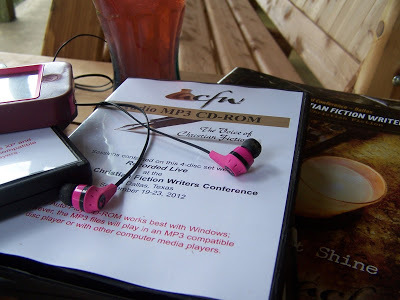 ACFW Original Photo Taken mid-day with Kodak DX6490 Uh...My Front PorchFirst, I decided where I wanted the text to be, placing it where it was visually the most appealing. I rotated the price just a bit clockwise. Then, thinking about the pink earbuds, I decided to use that to give some eye-popping color. Fun, flirty pink font at the bottom and at the top for the price. Next, I used the contrast and clarity tools to brighten the picture. I found the sunglasses in Overlays, made them pink and faded them out. The coup de grace was when I discovered the bright sunlight feature in Effects. I popped it over the top left-hand corner and added even more color with the yellow Summer Sale text. Use color and contrast to achieve the effect you want.
ACFW Original Photo Taken mid-day with Kodak DX6490 Uh...My Front PorchFirst, I decided where I wanted the text to be, placing it where it was visually the most appealing. I rotated the price just a bit clockwise. Then, thinking about the pink earbuds, I decided to use that to give some eye-popping color. Fun, flirty pink font at the bottom and at the top for the price. Next, I used the contrast and clarity tools to brighten the picture. I found the sunglasses in Overlays, made them pink and faded them out. The coup de grace was when I discovered the bright sunlight feature in Effects. I popped it over the top left-hand corner and added even more color with the yellow Summer Sale text. Use color and contrast to achieve the effect you want.
 Final version of ACFW CD Sale AdvertisementI’m going to share a SECRET TIP with those of you who want something just a little more advanced. Sometimes you want a shadowed font, but oftentimes free software doesn’t give you that option. I haven’t found shadowed fonts in PicMonkey, but you’ll see that I have some in the ACFW CD sale. The words “Summer Sale” and the “$89.95” have a dark gray shadow behind them. Here’s how I created that.
Final version of ACFW CD Sale AdvertisementI’m going to share a SECRET TIP with those of you who want something just a little more advanced. Sometimes you want a shadowed font, but oftentimes free software doesn’t give you that option. I haven’t found shadowed fonts in PicMonkey, but you’ll see that I have some in the ACFW CD sale. The words “Summer Sale” and the “$89.95” have a dark gray shadow behind them. Here’s how I created that.First add your text to your photo, formatting it as you would like it to appear.
Next, create a new text box and copy/paste the original font into the new text box. Make sure it’s the exact same size and shape as the original. The tool box will help you with this.
Reverse the font color so that it contrasts with the original, but also doesn’t blend into the background too much. If your reverse/shadow text box is in front of your primary color, use the Layer toolbox to Send backward.
And then shift your shadowed text box off-center just a little. Not much. You want the illusion of shadow, not something that jumps out at the viewer. That should give you a shadowed text. But don’t use shadows in long strings of text, only for emphasis and for contrast. ~ ~ ~I mentioned clarity earlier.
Sharpen and clarity are your friends.
Just be aware of what happens when you use these features, so work to get the mix just right. In some cases, too much can be ...uh... too much. Check out this picture that I posted on July 4th. I cropped out the date, of course. Used the Effects / Sharpen and Clarity tools to create eye-popping color.
 Original Photo taken on perfectly windy morning in June 2009 Hardy Manufacturing, Philadelphia, MS Pam Hillman, Kodak DX6490
Original Photo taken on perfectly windy morning in June 2009 Hardy Manufacturing, Philadelphia, MS Pam Hillman, Kodak DX6490
 American Flag - God Bless America!Can you see the difference?
American Flag - God Bless America!Can you see the difference?You might have to click on the pictures to see. The white is brighter, the red deeper, and there is a slight glow all around the flag. This is a good example of what a difference sharpen and clarity can make. I ended up putting a basic picture “frame” around this.
~ ~ ~Sometimes it doesn’t take much to create a PicMonkey masterpiece….
 Black Angus Bull - iPhone Broken Ended FarmsPam HillmanI took this shot with my iPhone while helping My Cowboy work cows. I was standing inches away, and the big guy was in the chute, so it wasn’t like he could get me. And he’s pretty gentle anyway...most of the time. I used Daguerreotype / Shiro and the picture needed no other work. I popped my website in the spot at the top where that piece of treated lumber was, and the words “I’ve got My Eye on You, Cowboy!” along the side. Pink font just felt right for some reason. Again, contrast.
Black Angus Bull - iPhone Broken Ended FarmsPam HillmanI took this shot with my iPhone while helping My Cowboy work cows. I was standing inches away, and the big guy was in the chute, so it wasn’t like he could get me. And he’s pretty gentle anyway...most of the time. I used Daguerreotype / Shiro and the picture needed no other work. I popped my website in the spot at the top where that piece of treated lumber was, and the words “I’ve got My Eye on You, Cowboy!” along the side. Pink font just felt right for some reason. Again, contrast.
 Black Angus Bull - Broken Ended Farms Bull's Eye!~ ~ ~Final tips:
Black Angus Bull - Broken Ended Farms Bull's Eye!~ ~ ~Final tips:Make sure you RENAME your creation when you’re done. You don’t want to override your original picture, and then have nothing to work with if you goof up.
Take your own pictures, purchase them, or at least make sure they are in creative commons. Get creative with your own shots. If you can shoot it, do it, then you can add your own website or name without concern.
Make sure you use proper grammar, check your spelling, and don’t leave words out. Nothing is more frustrating than seeing a meme on the internet with errors. No matter how cute or catchy, I will not share it.
Don’t just upload your masterpieces to Facebook, Twitter, and Pinterest. Sometimes this is okay, but even better, upload them to your blog and then pin them to Pinterest from your webpage or blog. That way it’s linked back to you. Instagram is such an amazing place for memes of all kinds, and the cool apps on mobile phones makes it all so easy.
PicMonkey is a quick, free (there is a paid version*) way to create a little buzz, and when I first wrote this blog post, you had to create and finalize your meme in one sitting. In addition, once you edited and saved your photo, then logged out of your online PicMonkey profile, you couldn't go back and edit or rework your creation. However, that's changed. With the paid version, PicMonkey offers something called the Hub. With the Hub, you can start a project, save it to the hub, then go back later and work on it some more. This is really cool because it never fails that I find something I want to change about a project.
*PicMonkey has a free version, but there is also a $33 yearly paid membership that gives more options. Some of the tools that I've used in these pictures come with the paid membership. If you're unsure of how much you might use the site, then opt for the free version until you're sure.Me? I knew I was going to enjoy it and signed up after about thirty minutes of playing. I hope you've enjoyed today's post as much as I enjoyed putting it together for you. Now, go out and have some fun with monkeys!
Next month I'm going to share about an app I have on my iPhone called Word Swag. I love, love, love Word Swag and it's my latest on-the-go, go-to design app that I use on my PHONE for all kinds of stuff. Yes, I still use PicMonkey (and sometimes use both on the same project if needed), but PicMonkey is like going to a sit-down restaurant to dine. Word Swag is ... fast food. And I'll have some fast food tips on making Word Swag work for you on the fly. Psst... the first meme in today's post was made using Word Swag. It took minutes!
Published on August 23, 2018 21:00
August 21, 2018
Write Your Feelings
Melanie Dickerson here.
Ten plus years ago when I was trying to get my first Medieval fairy tale retelling published, I was having no luck at all. It couldn’t have been any worse if I’d been selling ice makers to penguins in the North Pole. And penguins only live in the Southern Hemisphere. You get my point. Nobody wanted it because it was Medieval. Nobody wanted it because it was a YA romance. And nobody wanted it because I was nobody. You know?
Since Medievals and YA romances weren’t selling, I decided I’d better write something closer to what was selling, which was romances set in the 1800s in the U.S. I also got the idea that I was going to follow the advice I’d often heard, which was to “Write What You Know.” And since what I know is the South, having grown up and lived nearly my whole life in the Deep South, mostly Alabama, then I’d set a romance in 1800s Alabama.
 But looking back, I don’t think the advice to “write what you know” means to write books set in the places you are most familiar with. I think it has more to do with the writer’s own experiences and emotions. You can research a setting. After all, I’ve been writing books set in Medieval Europe and I’ve certainly never been there. I’ve been to Germany, but just being there for a few weeks doesn’t make me an expert. I’ve mostly learned about Medieval Germany from the internet, from pictures and books and videos.
But looking back, I don’t think the advice to “write what you know” means to write books set in the places you are most familiar with. I think it has more to do with the writer’s own experiences and emotions. You can research a setting. After all, I’ve been writing books set in Medieval Europe and I’ve certainly never been there. I’ve been to Germany, but just being there for a few weeks doesn’t make me an expert. I’ve mostly learned about Medieval Germany from the internet, from pictures and books and videos.
But in those books, I’ve written what I know. I’ve drawn on my experiences and given them to my characters. I’ve drawn on the emotions I’ve experienced going through certain situations and trials and I’ve transferred those to my heroes and heroines. And even my villains.
When I started writing Magnolia Summer, I’d just experienced, for the second time in my life, fainting in front of strangers, so I put it in that book. Yes, it is a cliché for a romance heroine to faint. And some people hate that. I got a wee bit of smack from readers over having my heroine from A Dangerous Engagement faint a few times. But fainting is something that’s happened to me. It’s something I know.
I know the emotions of it, how embarrassing it is, firsthand. So I used it in Magnolia Summer. And then, years later, I wrote it into Felicity’s story in A Dangerous Engagement, because hey, a little angst and drama are good for a story, and fainting is angsty and dramatic. And the truth is, there are people who are physically prone to fainting. My daughter also has this, and it’s frustrating. It doesn’t happen because you’re weak or wimpy or pathetic. It’s a physiological hiccup, and let me tell you, if your body decides to faint, there is nothing you can do to stop it.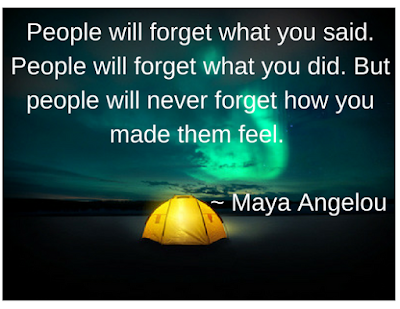
There are tons of other things that occur in Magnolia Summer that I know firsthand. In fact, the books in which I put my most personal experiences are the books that have a special place in my heart. Now, I’m not saying the exact things that happen in my books actually happened to me. But similar things, or things that produce the same type of emotions, happened to me. They’re what I know. I know what it feels like to be sexually harassed by an older man. That happened to me in my teens, and the same thing happened to Annabel in The Merchant’s Daughter. I used that experience and those feelings. I gave them to Annabel because they worked for the plot, and maybe also because I never intended to share that with anyone and I felt safe dealing with it in my book. (Sorry, Past Melanie. Present Melanie sometimes overshares.)
In Magnolia Summer, a rattlesnake is threatening a little girl. My heroine beats the snake to death with a stick. When I was teen, I came upon a rattlesnake next to our front steps that was only inches away from my puppy, who was completely oblivious to it. I shoved my puppy back, grabbed my long stick that I took with me on walks, and I bludgeoned that snake to death. So that scene in the book is pretty much identical to what happened to me, once my heroine grabs that stick.

Let it never be said of me that I wasted a dramatic experience from real life.
I also know what sweet, chivalrous, Southern men are like, and I tried really hard to duplicate that “Southern gentleman” experience in Magnolia Summer. Some of the Southern gentlemen in the book are only gentlemanly when it suits their purpose, as in the case of the villains in the book, Sheriff Suggs and his son, Curtis. But others, like my hero Truett Beverly, are the real deal—strong and soft-spoken and unfailingly heroic and chivalrous to women and children. I hope I captured what it feels like to have a man treat you that way. Because that’s what fiction is all about, making the reader FEEL. If I can make you feel something, I’ve done my job well.
I know the terror of the thought that I might have to give up my dream—in my case, writing, and in my heroine’s case, owning her own dress shop.
I know the pain of losing my father, which I had recently gone through when I wrote Magnolia Summer, and I gave that pain to my heroine.
I know what it’s like to want something so badly and yet, at the same time, to fear that it will ruin your life, so I gave that desire/terror to my heroine.
I know what it’s like to live in Alabama with no air conditioning. I know how Southerners speak and how it feels to have someone think you’re stupid just because you have a Southern accent. And I know how it feels to be nearly destitute and worry you won’t be able to buy food. I know how it feels to stand up for someone that others are mistreating. And I used all those feelings in this book.
Write what you know. Write your life experiences. Don’t let anything go to waste, hold nothing back. Don’t eat your feelings; write them.
So now it’s your turn. If you’re a writer, tell us in what ways you “write what you know” or “write your feelings” and life experiences. You don’t have to get too personal if you don’t want to, but it’s more interesting if you do. LOL!
And if you’re a reader, how do you think it increases your reading enjoyment if the emotion in a book feels real and authentic? Do you feel like you can detect whether a writer is writing their own feelings authentically, or just phoning it in?
One commenter will win either a paperback copy or an ebook copy of Magnolia Summer, which just released in paperback and will release on Kindle Sept. 5th.

Truett Beverly returned to Bethel Springs, Alabama, after finishing medical school. Fighting a secret war with a corrupt lawman wasn’t in his plans, but when Sheriff Suggs threatens his childhood friend, Truett dons a cape and hood and becomes the Hooded Horseman, placing him squarely in the sheriff’s crosshairs.
Celia Wilcox arrives in Bethel Springs in June of 1880. She’s come from Nashville to help her sister care for their younger siblings. She hopes only to be on the small farm for the summer, just until her mother recovers from the shock of Celia’s father’s death. She must return to Nashville in order to fulfill her dream of opening her own dress shop.
Celia catches Truett’s eye from the moment she steps off the train. He finds himself wanting to impress her, but she flatly refuses to flirt with him or to fall for his—if he does say so himself—considerable charm. Truth is, Celia’s attraction to Dr. Truett Beverly terrifies her. What will happen when Sheriff Suggs discovers Truett is the Hooded Horseman? Will Celia's greatest fears come true? Or will she be able to prevent the sheriff from carrying out one last lynching?
Pre-order the ebook, which releases Sept. 5th, or order the paperback, available NOW.
Ten plus years ago when I was trying to get my first Medieval fairy tale retelling published, I was having no luck at all. It couldn’t have been any worse if I’d been selling ice makers to penguins in the North Pole. And penguins only live in the Southern Hemisphere. You get my point. Nobody wanted it because it was Medieval. Nobody wanted it because it was a YA romance. And nobody wanted it because I was nobody. You know?
Since Medievals and YA romances weren’t selling, I decided I’d better write something closer to what was selling, which was romances set in the 1800s in the U.S. I also got the idea that I was going to follow the advice I’d often heard, which was to “Write What You Know.” And since what I know is the South, having grown up and lived nearly my whole life in the Deep South, mostly Alabama, then I’d set a romance in 1800s Alabama.
 But looking back, I don’t think the advice to “write what you know” means to write books set in the places you are most familiar with. I think it has more to do with the writer’s own experiences and emotions. You can research a setting. After all, I’ve been writing books set in Medieval Europe and I’ve certainly never been there. I’ve been to Germany, but just being there for a few weeks doesn’t make me an expert. I’ve mostly learned about Medieval Germany from the internet, from pictures and books and videos.
But looking back, I don’t think the advice to “write what you know” means to write books set in the places you are most familiar with. I think it has more to do with the writer’s own experiences and emotions. You can research a setting. After all, I’ve been writing books set in Medieval Europe and I’ve certainly never been there. I’ve been to Germany, but just being there for a few weeks doesn’t make me an expert. I’ve mostly learned about Medieval Germany from the internet, from pictures and books and videos. But in those books, I’ve written what I know. I’ve drawn on my experiences and given them to my characters. I’ve drawn on the emotions I’ve experienced going through certain situations and trials and I’ve transferred those to my heroes and heroines. And even my villains.
When I started writing Magnolia Summer, I’d just experienced, for the second time in my life, fainting in front of strangers, so I put it in that book. Yes, it is a cliché for a romance heroine to faint. And some people hate that. I got a wee bit of smack from readers over having my heroine from A Dangerous Engagement faint a few times. But fainting is something that’s happened to me. It’s something I know.
I know the emotions of it, how embarrassing it is, firsthand. So I used it in Magnolia Summer. And then, years later, I wrote it into Felicity’s story in A Dangerous Engagement, because hey, a little angst and drama are good for a story, and fainting is angsty and dramatic. And the truth is, there are people who are physically prone to fainting. My daughter also has this, and it’s frustrating. It doesn’t happen because you’re weak or wimpy or pathetic. It’s a physiological hiccup, and let me tell you, if your body decides to faint, there is nothing you can do to stop it.

There are tons of other things that occur in Magnolia Summer that I know firsthand. In fact, the books in which I put my most personal experiences are the books that have a special place in my heart. Now, I’m not saying the exact things that happen in my books actually happened to me. But similar things, or things that produce the same type of emotions, happened to me. They’re what I know. I know what it feels like to be sexually harassed by an older man. That happened to me in my teens, and the same thing happened to Annabel in The Merchant’s Daughter. I used that experience and those feelings. I gave them to Annabel because they worked for the plot, and maybe also because I never intended to share that with anyone and I felt safe dealing with it in my book. (Sorry, Past Melanie. Present Melanie sometimes overshares.)
In Magnolia Summer, a rattlesnake is threatening a little girl. My heroine beats the snake to death with a stick. When I was teen, I came upon a rattlesnake next to our front steps that was only inches away from my puppy, who was completely oblivious to it. I shoved my puppy back, grabbed my long stick that I took with me on walks, and I bludgeoned that snake to death. So that scene in the book is pretty much identical to what happened to me, once my heroine grabs that stick.

Let it never be said of me that I wasted a dramatic experience from real life.
I also know what sweet, chivalrous, Southern men are like, and I tried really hard to duplicate that “Southern gentleman” experience in Magnolia Summer. Some of the Southern gentlemen in the book are only gentlemanly when it suits their purpose, as in the case of the villains in the book, Sheriff Suggs and his son, Curtis. But others, like my hero Truett Beverly, are the real deal—strong and soft-spoken and unfailingly heroic and chivalrous to women and children. I hope I captured what it feels like to have a man treat you that way. Because that’s what fiction is all about, making the reader FEEL. If I can make you feel something, I’ve done my job well.
I know the terror of the thought that I might have to give up my dream—in my case, writing, and in my heroine’s case, owning her own dress shop.
I know the pain of losing my father, which I had recently gone through when I wrote Magnolia Summer, and I gave that pain to my heroine.
I know what it’s like to want something so badly and yet, at the same time, to fear that it will ruin your life, so I gave that desire/terror to my heroine.
I know what it’s like to live in Alabama with no air conditioning. I know how Southerners speak and how it feels to have someone think you’re stupid just because you have a Southern accent. And I know how it feels to be nearly destitute and worry you won’t be able to buy food. I know how it feels to stand up for someone that others are mistreating. And I used all those feelings in this book.
Write what you know. Write your life experiences. Don’t let anything go to waste, hold nothing back. Don’t eat your feelings; write them.
So now it’s your turn. If you’re a writer, tell us in what ways you “write what you know” or “write your feelings” and life experiences. You don’t have to get too personal if you don’t want to, but it’s more interesting if you do. LOL!
And if you’re a reader, how do you think it increases your reading enjoyment if the emotion in a book feels real and authentic? Do you feel like you can detect whether a writer is writing their own feelings authentically, or just phoning it in?
One commenter will win either a paperback copy or an ebook copy of Magnolia Summer, which just released in paperback and will release on Kindle Sept. 5th.

Truett Beverly returned to Bethel Springs, Alabama, after finishing medical school. Fighting a secret war with a corrupt lawman wasn’t in his plans, but when Sheriff Suggs threatens his childhood friend, Truett dons a cape and hood and becomes the Hooded Horseman, placing him squarely in the sheriff’s crosshairs.
Celia Wilcox arrives in Bethel Springs in June of 1880. She’s come from Nashville to help her sister care for their younger siblings. She hopes only to be on the small farm for the summer, just until her mother recovers from the shock of Celia’s father’s death. She must return to Nashville in order to fulfill her dream of opening her own dress shop.
Celia catches Truett’s eye from the moment she steps off the train. He finds himself wanting to impress her, but she flatly refuses to flirt with him or to fall for his—if he does say so himself—considerable charm. Truth is, Celia’s attraction to Dr. Truett Beverly terrifies her. What will happen when Sheriff Suggs discovers Truett is the Hooded Horseman? Will Celia's greatest fears come true? Or will she be able to prevent the sheriff from carrying out one last lynching?
Pre-order the ebook, which releases Sept. 5th, or order the paperback, available NOW.
Published on August 21, 2018 21:00
August 19, 2018
Balancing Writing and Life
by Jan Drexler
About a year ago, I realized I was no longer having fun.
Between writing and things going on in my personal life, stress was my middle name. I was living on caffeine. Chocolate was my drug of choice. I wasn't sleeping well. I didn’t even feel like I could take time off to have lunch with friends…
Wait a minute! This is my dream job! I don’t want to live this way!
Something needed to change, and I didn’t want it to be my writing. I had worked hard (and am still working hard) to be a published author. I want this to be a lifetime career, not just something to keep me busy for a few years.
I still have a LOT of stories to write!
It took some time, but I figured out what the problem was.
It was me .

Here’s how it happened -
In my past life (before writing), I was a homeschool mom. It was the most rewarding thing I’ve ever done, without exception. But it was also extremely time consuming. Every minute of my day was booked.
In an attempt to control the chaos, I put our homeschool on a six week/one week schedule, using the one week off to catch up with cleaning the house and other major projects that needed my attention.
It was a marvelous and hectic time. And yes, I’d do it all over again!
My schedule became a habit. One that carried over to my writing career. In the early days, it worked. I would meet a deadline, then take a week or two off to catch up with the rest of my life.
But a few years ago, things changed. I signed my first three-book contract with Revell. When I signed another three-book contract with Love Inspired Historical a couple years later, time really got tight.
Suddenly, I no longer had a break between deadlines. I also had all the other “mini-deadlines” associated with publication: revisions, line edits, titling and positioning information, input on cover design, guest blogging, radio interviews…. and my life outside of writing became chaos.
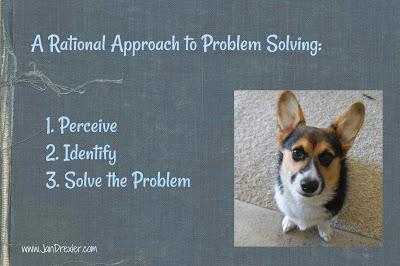
I started seeing a pattern, and with the pattern, I was able to identify the problem.
Yes, my problem is that I tend to tackle each part of my life with single-minded focus. Of course, the downside with that is there are many facets to my life!
Maybe a lot of you struggle with the same thing.
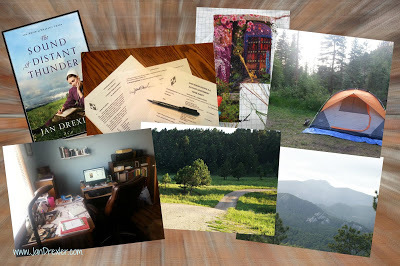
Once I found the cause – my single-focused method of tackling any job – it was time to find a solution.
Since I can't change my God-given personality quirk, I decided to try to use that facet of my personality as a strength. Harness the power of that single-mindedness for good! Become a super-hero!
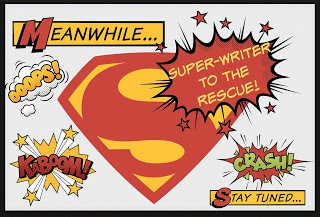
Scheduling is the method I’m using again. It has worked for me in the past, and I have confidence it will help me this time.
However, another personality quirk of mine is that while I love making schedules, I’m a rebel when it comes to following them!
I’m determined to make this work, though. I don’t want to crash and burn, so I need to bring balance to my life and my work. I follow my schedule with grace – there is give and take along the way – but I get things done.
And progress is the result.
In case you’re curious, here is my schedule outline:
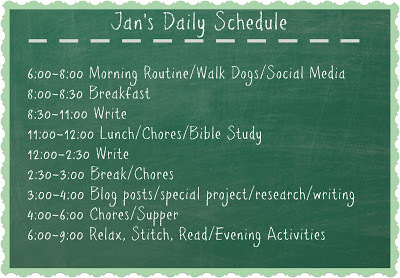
Today I’d like to discuss how you balance your writing with the rest of your life. Has writing taken over all your time and energy? Or are you having trouble fitting the writing time in?
For readers: If you're anything like me, reading threatens to consume your time! How do you balance life, reading, and reviewing?
Or if you are one of those few brave souls who have found the secret of balancing the tasks in your life, share what works for you! We can all learn from each other!
One commenter today will win a copy of my newest release, “The Sound of Distant Thunder,” available for pre-order now!
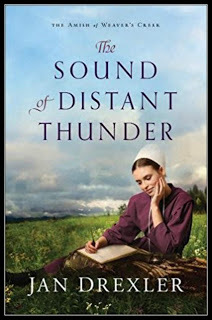 Katie Stuckey and Jonas Weaver are both romantics. Seventeen-year-old Katie is starry-eyed, in love with the idea of being in love, and does not want to wait to marry Jonas until she is eighteen, despite her parents' insistence. So much can happen in a year. Twenty-year-old Jonas is taken in by the romance of soldiering, especially in defense of anti-slavery, even though he knows war is at odds with the teachings of the church. When his married brother's name comes up in the draft list, he volunteers to take his brother's place. But can the commitment Katie and Jonas have made to each other survive the separation?
Katie Stuckey and Jonas Weaver are both romantics. Seventeen-year-old Katie is starry-eyed, in love with the idea of being in love, and does not want to wait to marry Jonas until she is eighteen, despite her parents' insistence. So much can happen in a year. Twenty-year-old Jonas is taken in by the romance of soldiering, especially in defense of anti-slavery, even though he knows war is at odds with the teachings of the church. When his married brother's name comes up in the draft list, he volunteers to take his brother's place. But can the commitment Katie and Jonas have made to each other survive the separation?
From the talented pen of Jan Drexler comes this brand new Amish series set against the backdrop of the Civil War. She puts her characters to the test as they struggle to reconcile their convictions and desires while the national conflict threatens to undermine and engulf their community.
About a year ago, I realized I was no longer having fun.
Between writing and things going on in my personal life, stress was my middle name. I was living on caffeine. Chocolate was my drug of choice. I wasn't sleeping well. I didn’t even feel like I could take time off to have lunch with friends…
Wait a minute! This is my dream job! I don’t want to live this way!
Something needed to change, and I didn’t want it to be my writing. I had worked hard (and am still working hard) to be a published author. I want this to be a lifetime career, not just something to keep me busy for a few years.
I still have a LOT of stories to write!
It took some time, but I figured out what the problem was.
It was me .

Here’s how it happened -
In my past life (before writing), I was a homeschool mom. It was the most rewarding thing I’ve ever done, without exception. But it was also extremely time consuming. Every minute of my day was booked.
In an attempt to control the chaos, I put our homeschool on a six week/one week schedule, using the one week off to catch up with cleaning the house and other major projects that needed my attention.
It was a marvelous and hectic time. And yes, I’d do it all over again!
My schedule became a habit. One that carried over to my writing career. In the early days, it worked. I would meet a deadline, then take a week or two off to catch up with the rest of my life.
But a few years ago, things changed. I signed my first three-book contract with Revell. When I signed another three-book contract with Love Inspired Historical a couple years later, time really got tight.
Suddenly, I no longer had a break between deadlines. I also had all the other “mini-deadlines” associated with publication: revisions, line edits, titling and positioning information, input on cover design, guest blogging, radio interviews…. and my life outside of writing became chaos.

I started seeing a pattern, and with the pattern, I was able to identify the problem.
Yes, my problem is that I tend to tackle each part of my life with single-minded focus. Of course, the downside with that is there are many facets to my life!
Maybe a lot of you struggle with the same thing.

Once I found the cause – my single-focused method of tackling any job – it was time to find a solution.
Since I can't change my God-given personality quirk, I decided to try to use that facet of my personality as a strength. Harness the power of that single-mindedness for good! Become a super-hero!

Scheduling is the method I’m using again. It has worked for me in the past, and I have confidence it will help me this time.
However, another personality quirk of mine is that while I love making schedules, I’m a rebel when it comes to following them!
I’m determined to make this work, though. I don’t want to crash and burn, so I need to bring balance to my life and my work. I follow my schedule with grace – there is give and take along the way – but I get things done.
And progress is the result.
In case you’re curious, here is my schedule outline:

Today I’d like to discuss how you balance your writing with the rest of your life. Has writing taken over all your time and energy? Or are you having trouble fitting the writing time in?
For readers: If you're anything like me, reading threatens to consume your time! How do you balance life, reading, and reviewing?
Or if you are one of those few brave souls who have found the secret of balancing the tasks in your life, share what works for you! We can all learn from each other!
One commenter today will win a copy of my newest release, “The Sound of Distant Thunder,” available for pre-order now!
 Katie Stuckey and Jonas Weaver are both romantics. Seventeen-year-old Katie is starry-eyed, in love with the idea of being in love, and does not want to wait to marry Jonas until she is eighteen, despite her parents' insistence. So much can happen in a year. Twenty-year-old Jonas is taken in by the romance of soldiering, especially in defense of anti-slavery, even though he knows war is at odds with the teachings of the church. When his married brother's name comes up in the draft list, he volunteers to take his brother's place. But can the commitment Katie and Jonas have made to each other survive the separation?
Katie Stuckey and Jonas Weaver are both romantics. Seventeen-year-old Katie is starry-eyed, in love with the idea of being in love, and does not want to wait to marry Jonas until she is eighteen, despite her parents' insistence. So much can happen in a year. Twenty-year-old Jonas is taken in by the romance of soldiering, especially in defense of anti-slavery, even though he knows war is at odds with the teachings of the church. When his married brother's name comes up in the draft list, he volunteers to take his brother's place. But can the commitment Katie and Jonas have made to each other survive the separation?From the talented pen of Jan Drexler comes this brand new Amish series set against the backdrop of the Civil War. She puts her characters to the test as they struggle to reconcile their convictions and desires while the national conflict threatens to undermine and engulf their community.
Published on August 19, 2018 21:00
August 17, 2018
Weekend Edition

If you are not familiar with our giveaway rules, take a minute to read them here. It keeps us all happy! All winners should send their name, address, and phone number to claim prizes. Note our new email address and please send your emails to Seekerville2@gmail.com

Monday: We all were winners of a virtual beach retreat brought to us by Missy Tippens! However, the winner of the tote bag and a copy of His Summer Valentine is Connie Porter Saunders!
Wednesday: Publishers Weekly Bestselling author Debby Giusti asked, "Who is Rosie Glick?" in her blog post that also included a few snapshots from Debby's personal Amish photo collection. In addition, Debby held a drawing for a copy of the fourth and final book in her Amish Protectors series, which is Rosie Glick's story. Congrats to Nicole House. Nicole, you won a copy of Amish Christmas Secrets!
Friday: There is no doubt that a series of connected stories, when executed well, are big hits with readers, right? Winnie Griggs cataloged the pros and cons well! The winner of all 4 books of the Knotty Pine series is Tanya Agler. And the winner of the Journeys of the Heart Novella collection is Sandy Smith.

Monday: Jan Drexler will be here talking about balance. Is your life out of whack? Are you having trouble fitting your writing and/or reading time into your busy life? We'll be discussing the problem and some solutions (hopefully), so bring your ideas! And one commenter will win a copy of Jan's newest release and book one of a new series from Revell, The Sound of Distant Thunder, releasing September 18th!
Wednesday: Join us as Melanie Dickerson talks about how to find plot ideas and how to "write what you know" at the same time, using her first Southern Historical Romance as an example. Friday: Pam Hillman is your host today. When this WE went to press, she was pursuing a really cool idea for Friday's post. Come back and let's see how it panned out! :)

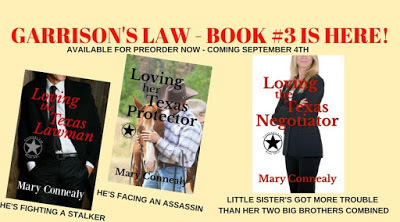 Garrison's Law book #3
Loving the Texas Negotiator
Available for Pre-Sale nowComing September 4th
Garrison's Law book #3
Loving the Texas Negotiator
Available for Pre-Sale nowComing September 4th Not all the Garrisons are guys.
Beth Garrison is the top hostage negotiator in Rocky Ridge, Texas. She's called to serve on a task force to investigate a killing that is a copycat of her first bust as a rookie.
Tate McCade has a reputation for steamrolling anyone who gets in his way and he's had a run-in with Beth and her oversized ego before. He's got a bruise on his face to prove it.
They have to work together and sparks are flying that aren’t all about the job.
Speaking of Mary Connealy, Carrie stopped by to visit her at Barnes & Noble on Book Lovers' Day! Well, ok, not Mary herself (sadly) but her books, which are the next best thing!
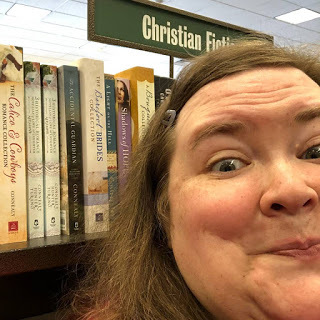
Winnie's Publisher is giving two of her books a refresh, putting then out with gorgeous new covers. Check them out below. And to learn more about the books themselves, just click on the covers.
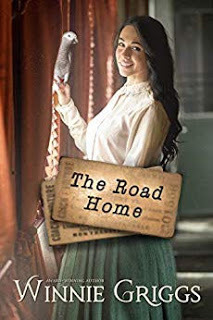
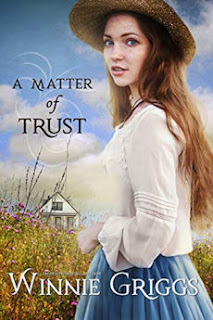
Rosie Glick's story available for pre-order!

AMISH CHRISTMAS SECRETSBy Debby Giusti Pre-order here!

Missy was a guest blogger at the Inspy Romance blog and did a fun post about where book ideas come from!
 Don't forget to enter daily for Pam Hillman's Natchez Trace Takeover Tour Giveaway with JustRead Publicity Tours! Pam is giving away a basket of goodies including these two lovelies! Hurry, ends on 8/20!
Don't forget to enter daily for Pam Hillman's Natchez Trace Takeover Tour Giveaway with JustRead Publicity Tours! Pam is giving away a basket of goodies including these two lovelies! Hurry, ends on 8/20!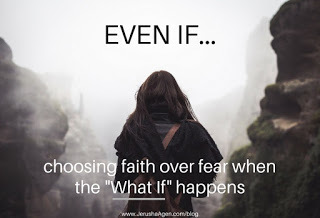
Carrie is guest blogging over at Jerusha Agen's marvelous Fear Warriors blog, talking about choosing 'even if' faith when the 'what if' happens.

If you're in the Hanover, Maryland area today, stop on by the Girl Scouts' Community Day at St. Mark United Methodist Church Community Day & Shred-It Event.
In case you are not familiar, JustRead Book Boxes is a monthly book box featuring clean reads with an inspirational element plus a curation of several good quality items that complement the featured title. You can also buy directly from our Etsy shop.
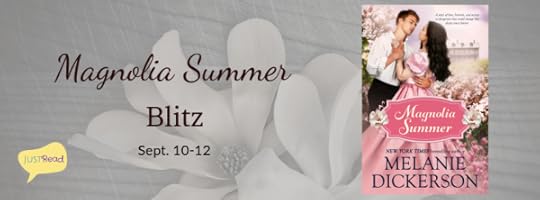

Melanie Dickerson's upcoming release, Magnolia Summer is available for preorder, plus on tour with JustRead Publicity Tours! Click on the banners above to take you straight to their respective sign up forms. Hurry! Sign up closes on August 20, 2018.

How to Intertwine Plot, Character, and Theme in Every Scene by K.M. Weiland.
Nonfiction Writers: Beware the Curse of Knowledge by Anne Janzer on Jane Friedman's blog.
7 Mistakes that Make Every Writer Look Unprofessional by DiAnn Mills.
How to Write Attention-Grabbing Promo Copy for Books by M.J. Rose, guest blogger at BookBub.
Why Writing Can Be The Best Way To Deal With Adversity by Joanna Penn, The Creative Penn
Finding My Voice - So Easy. So Hard, by Vaughn Roycroft from Writer Unboxed.
Published on August 17, 2018 21:00
August 16, 2018
The Joys and Challenges of Crafting A Series of Connected Stories
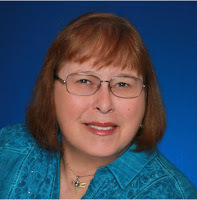 Hi all, Winnie Griggs here. Today I want to talk about one of my favorite subjects, namely Connected Stories.
Hi all, Winnie Griggs here. Today I want to talk about one of my favorite subjects, namely Connected Stories. Connected stories refers to a multi-book series written by one or more authors where all the stories have one or more connecting thread.
As a reader I’ve always loved them. After all, what can be better than knowing that the characters and story world you’ve just invested so much time and emotion into are going to show up again in one or more books to come.
On the other hand, as an author it never occurred to me to try to write a series of connected stories myself, at least not until I wrote my seventh book, The Christmas Journey. The heroine and hero of that book each had siblings who really tugged at me to tell their stories. I ended up writing two more novels and one novella in the story world of Knotty Pine, Texas.
Since then I’ve completed a ten-book series called The Texas Grooms and participated in the three book Irish Brides continuity with two other authors. I’ve also got another couple of series in the works that I’ll talk about in another post.
For those of you interested in crafting a series of your own, I thought I’d share a few insights I picked up along the way.
FIRST, HOW DO YOU KNOW IF YOUR IDEA IS RIGHT FOR A SERIES

Not every story lends itself to being part of a series. Some are stand alone and rightfully so. On the other hand:Do you have one or more secondary characters who are strong enough to carry their own book? Do you have a theme or trope you want to explore in several ways with different characters? Do you have one character whose story and/or growth arc you want to tell over multiple books?If you can answer yes to any of these questions, then you MIGHT have the makings of a series.Other things you need to consider:Can you make the books in your series different and intriguing enough to hold your readers’ interest, but alike enough to make each feel like part of a cohesive series? Do you have the discipline as a writer to stick with the series to the end? Are you organized enough to keep up with all your character and story world details from book to book?If this is a multi-author series, do you play well with others or are you more of a lone wolf when it comes to writing projects?
SO, WHAT ARE SOME OF THE WAYS TO CONNECT STORIES

There are a number of different ways to tie your series of stories together. Some ways you can connect them are:
For examples of this type of connecting thread, think of book series featuring characters like Sherlock Holmes, Stephanie Plum, or Harry Potter.
· Through a cast of characters connected by family, where a different member of the family is each featured in their own book. Examples of these type series are: * Debby Giusti’s Amish Protectors series – the heroines of the three original books are all sisters* The Seven Brides for Seven Texans series headed up by Erica Vetsch – the seven Texans referred to in the series title are all brothers* The 6 book Texas Twins Love Inspired continuity that Glynna Kaye participated in is built around siblings* Jan Drexler’s The Journey to Pleasant Prairieseries also has interwoven sibling connections* Mindy Obenhaus’s Rocky Mountain Heroesseries revolves around the stories of 5 brothers.* My own Knotty Pines series is connected by a tapestry of siblings.
· Through a cast of characters connected by occupation or vocation. Examples include: * Debby Giusti’s Magnolia Medical series where the heroes and heroines are scientists at the same laboratory in Atlanta.* The Seven Brides for Seven Texas Rangersseries headed up by Erica Vetsch features heroes who are all Texas Rangers from the same squad
· Through a common location or community. Some examples are: * Glynna Kaye’s Hearts of Hunter Ridge series all take place in the same small Arizona mountain town.* Mary Connealy’s Montana Marriages series feature heroes who all live in proximity to each other* My own 10 book Texas Grooms series are all set in the fictional town of Turnabout, Texas and feature a community of recurring characters
· Through a cast of characters with a shared experience. Examples are:* Mary Connealy’s Trouble In Texas series – all three of the heroes were prisoners in Andersonville* The first 4 books of my Texas Groomsseries – this was originally conceived as a four book series (later expanded to ten) featuring the 4 men who came to Texas from Pennsylvania to take part in a marriage lottery of sorts
· Through a theme or trope. An example of this is:* Ruth Logan Herne’s Double S Ranch western series – these stories loosely portray the three men from the Prodigal Son story* Melanie Dickerson’s Fairy Tale Romance series – each book in the series is a reimagining of a classic fairytale.* Erica Vetsch and I contributed to Journeys of the Heart, a three-author novella collection where the three stories were connected simply by the theme of travel across distances and from an old life to a new one.
If you’re familiar with the books in the examples above, you’ll notice there are several that could have fit under more than one category – this is not unusual. There are probably other way to connect stories, but I think this covers the most common ones.
Now let’s discuss some pros and cons of writing connected series.

PROS
They help to build a reader following – as I said at the opening of this post, readers love connected stories. If the first book in the series does its job well, you’ll have readers eagerly looking forward to the next book in the series Writing connected stories can help you write faster. This is because, in most cases, you’ve already done most of the work of building your story world when you wrote the first book of the series. Subsequent books will only require that you build on this rather than forcing you to start over from scratch. Connected stories allow you to play with a larger story arc. With a series of connected books, you can expand themes and story arcs across multiple books rather than relegating them to the confines of one book. With connected stories, depending on the type of connection, you can often revisit characters. Those characters you’ve invested so much time and emotion in can now live beyond the pages of their own book and make appearances in future books as secondary characters.
CONS
There’s no getting around it - it’s a challenge to set everything up correctly. When you’re planning to write a series, it is crucial that you set up your story world and its inhabitants in the very first book in a manner that will support all the subsequent books. This can be especially tricky if you don’t have a firm idea of where you want the series to go.Then there’s the challenge of including backstory from prior stories into your subsequent books. You want readers who might pick up a book in the middle of the series to be comfortable in the world you’ve created and at the same time you want readers who have been with you from the beginning not to feel like you’re weighing down the current story with too much repetition of ‘what came before’. It’s a delicate backstory balancing act that you’ll have to learn to master.Writing connected stories forces you to keep up with minor details from prior books. When you’re working on a series of connected books it’s important to come up with a good system to keep up with all the little details that may appear from book to book - what is the name of the school’s principle, what street is the library on, is the river east or west of town, what’s the name of that dog that showed up in book 1 - those sorts of things.There’s the danger of getting in a rut - writing about the same story world with the same cast of characters can sometimes lead to you as a writer getting tired of the whole thing before you reach the conclusion of your series. This can be disastrous, not only for your sense of fulfillment as a writer, but also for your readers – a lack of enthusiasm on the writer’s part will often translate into a so-so story for the reader.You can also run into trouble meeting reader expectations for your vision. Readers will form their own expectations of what subsequent books in the series should focus on. They’ll form attachments to secondary characters that you may or may not plan to feature in the future. Or they will try to pair up characters that you have other things in mind for. This is not necessarily a bad thing – it shows the readers are really invested in your series. But, as the author, you need to be prepared to respond to this sort of feedback.
Do the pros to writing a series outweigh the cons? That’s a personal question that will be answered differently for each author and each series. But there is no doubt that a series of connected stories, when executed well, are big hits with readers.

So, how do you feel about connected stories? And what did I miss in my analysis?Join the discussion - I'll be selecting one person from those who leaves comments to receive all 4 books in my Knotty Pine series, and one person to receive a copy of the Journey's of the Heart novella collection that features stories from me and Erica.
Published on August 16, 2018 22:00
August 14, 2018
Who is Rosie Glick?
 By Debby Giusti
By Debby Giusti“Who’s Rosie Glick?”
If someone had asked me that question two years ago, I would have replied with a shrug, “I dunno.”
At that time, I didn’t know Rosie would be the heroine in Amish Christmas Secrets, the fourth and final book in my Amish Protectors series. In fact, I didn’t even know Rosie existed.
 An Amish farm in Holmes County, Ohio, similar to the farm
An Amish farm in Holmes County, Ohio, similar to the farmwhere Ezra Stoltz lives.I had submitted a proposal that featured three sisters caught in a human trafficking operation located in the North Georgia mountains. Two of the sisters--Miriam Miller (Amish Refuge-book 1) and Sarah Miller (Amish Rescue-book 3)—were taken captive in a carjacking on a desolate back road. Their estranged sister, Hannah Miller (Undercover Amish-book 2), travels to the mountain area in search of them and ends up in danger as well.
Spoiler alert…although we all know the stories have a HEA! Each sister falls in love with an Amish, or soon-to-be Amish, hero who fights the bad guys in an exciting climax. The heroes declare their love and the couples live happily ever after.
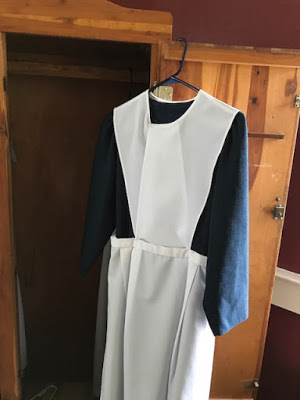 This is an Amish woman's wedding dress. Will
This is an Amish woman's wedding dress. WillRosie Glick get her happily ever after?
Emily Rodmell, my wonderful editor from Love Inspired Books, eagerly accepted the proposal, then added a fourth book to the contract.
Three sisters = three books.
A four-book contract was a good problem. I quickly decided the add-on book would begin a new series.
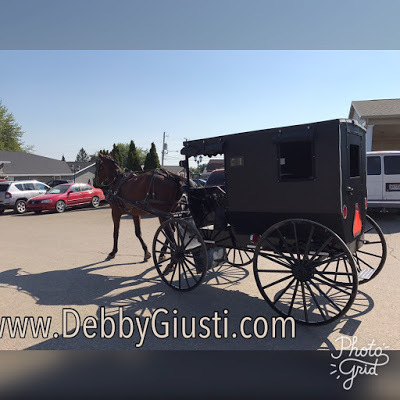 I love Amish buggies!
I love Amish buggies!But my plans changed when Rosie pushed her way into the first book and showed up again in book 2 and 3.
 This could be a photo from Ezra Stoltz's house.
This could be a photo from Ezra Stoltz's house.How?
An interesting phenomenon happens when I’m writing. Often a character, plot twist or line of dialogue I never planned to include in a story appears on the page. Early in my career, I would roll my eyes and blame my typing error on fatigue or writer overload and would immediately delete the material I had mistakenly added. Before long, I realized that surprise character or new information was exactly who or what I needed later in the story.
 A small garden close to the house.
A small garden close to the house.In one of my earlier books, a villain’s sister made an unexpected appearance. I didn’t even know he had a sister, but she played a pivotal role in the intriguing climax.
Rosie Glick was born in just such a way. She came to life when the sheriff in book 1 mentioned an Amish women who had gone missing some months earlier and was thought to have run off with her Englisch boyfriend.
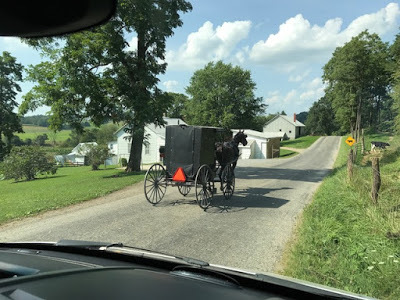 I wonder if Ezra and Rosie are in that buggy?In book 2, Hannah Miller and her cop-turned-Amish-hero, Lucas Grant, question Rosie’s parents to find out if her disappearance has something to do with another missing Amish girl. Rosie’s father is less than forthright, but her mother, in that same unexpected way, shares the surprise clue I needed in order to discover what had happened to Rosie.
I wonder if Ezra and Rosie are in that buggy?In book 2, Hannah Miller and her cop-turned-Amish-hero, Lucas Grant, question Rosie’s parents to find out if her disappearance has something to do with another missing Amish girl. Rosie’s father is less than forthright, but her mother, in that same unexpected way, shares the surprise clue I needed in order to discover what had happened to Rosie.By the time I wrote the third story, Rosie was demanding her own book, and I could clearly see who she was and what she wanted revealed.
 A pretty view through the window of an Amish home,
A pretty view through the window of an Amish home,Holmes County.
Over the years, I’ve come to realize those unexpected elements don’t come from me, they come from God. I start with a tiny idea of what I want to write—a series about three sister caught in a trafficking operation–and somehow the stories take shape and new characters appear that I never would have imagined at the onset.
The process of creating a story or a series from an initial idea is like the small mustard seed Christ talked about in Scripture that grew to the largest of plants. The process is bigger than I am, and I know the Lord provides the inspiration and I’m merely his scribe.

Writers, have you experienced a surprise character or an unexpected plot twist or bit of dialogue that ends up enhancing your story? Readers, do you mind if a new character is introduced later in the story or do you want everyone “on the page” in the beginning chapters? Do you enjoy reading books in a series, and if so, do you read the stories as soon as they’re released or do you wait until the last book is published and then read the entire series beginning to end?
Leave a comment to be entered in a drawing for Amish Christmas Secrets so you can learn more about Rosie Glick, the surprise heroine in my Amish Protectors series.
Happy writing! Happy reading!
Wishing you abundant blessings,Debby Giustiwww.DebbyGiusti.com
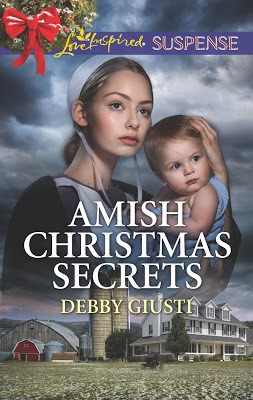
AMISH CHRISTMAS SECRETSBy Debby Giusti
Safe Haven for the HolidaysThe thrilling Amish Protectors conclusion.
Leaving the nursing home where she works, Rosie Glick’s accosted by a man demanding incriminating evidence her murdered boyfriend stole—until Ezra Stoltz scares him off. Now with a killer dead set on silencing the Amish single mother, Ezra must hide Rosie and her baby to keep them safe. But can he expose a sinister conspiracy in time to save the woman he secretly loves?
Pre-order here!
Published on August 14, 2018 21:00
August 12, 2018
A Virtual Beach Retreat for Writers!
Missy Tippens
It's been several years since I held a virtual retreat here at the blog. So I thought I'd re-share the retreat I posted for you in 2012. I hope you enjoy another writing retreat at the beach! Be sure to turn up your sound on the videos. Well worth it for the relaxation. :)
Before we start, though, I wanted to share some inspiration. I just read an article at CNN.com by Ashley Strickland about the launching of the Parker Solar Probe. I was very moved by the end of the article (click here to read). For the first time, NASA named a spacecraft in honor of a living person. In 1958, as a young physicist at University of Chicago, Eugene Parker submitted a paper to a journal predicting the existence of solar winds. The "referees" of the journal rejected it as "radical." But Parker appealed to the editor, Subrahmanyan Chandrasekhar (winner of a Nobel Prize in Physics in 1983), who ended up publishing the paper. Later, Parker's theory was confirmed. Today, Parker is the S. Chandrasekhar Distinguished Service Professor Emeritus at the University of Chicago. He's also been given NASA's distinguished public service medal...and has a spacecraft named after him that will be the first to go to the sun. How cool is that?
I hope this inspires you as much as it did me! And now...on to our virtual beach retreat...

Missy, here, coming to you with a little more tan and a lot more freckles! Our family just returned from a vacation on the beautiful Alabama coast. Spent a glorious week at the beach with my husband and three kids. Once again, I thought I'd share! Today, you can have your very own mini-writing retreat. :)
Good morning! Time to get up and spend some peaceful time on the balcony. A nice cup of coffee, your Bible and a deserted, quiet beach await.
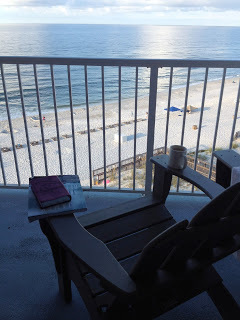
Once you finish breakfast and your devotional, it's time to write! The sound of the ocean waves hitting the shore is the perfect white noise for me. I hope it speaks to you like it does to me! Here's your morning soundtrack.
And a special treat! We saw a double rainbow one morning!

So after a session of writing, the beach is filling and the kids at the pool are starting in on a game of Marco-Polo. It's difficult to concentrate now, so it's probably time to break for lunch on the balcony and a little time at the pool or beach yourself. Here's your afternoon soundtrack...
After lunch, head down for digging your toes in the sand...

...and setting up to read under your beach umbrella! Because remember how much we learn about writing from reading. :)

If you'd like to work for a while down on the beach, here's your afternoon beach soundtrack...
Once you're done, it's time to quit for the day and spend time with the family. Time for a beautiful dinner at your favorite restaurant on the bay, where you can look at all the yachts and dream about how it might feel to own one.


Then back to the condo to watch the glorious sunset...

Ahhhh. I don't know about you, but I feel relaxed and inspired to start again tomorrow. Do you feel rested? Did you get a lot accomplished on your retreat? :) What's your favorite place to write? Let's chat about writing retreats.
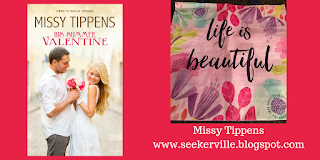
Today, I'm giving away a tote bag that says "Life is Beautiful" as well as a Kindle copy of my indie novella His Summer Valentine to one lucky winner!
Speaking of His Summer Valentine ... If you didn't read it in the Coffee Shop Romances boxed set, then be sure to get your copy today! And if you've already read it, please consider leaving a review. They're really helpful to authors!
Let me know in the comments if you'd like to be entered for the giveaway!
*******************
His Summer Valentine
Opposites attract in this novella-length inspirational romance (Christian romance) Book 1!
Willow Valentine is on a quest—granted, a crazy one. When her car breaks down in the middle of a 4th of July parade in the tiny town of Dahlia, Georgia, she can’t help but wonder if God was bringing her here all along. After the handsome Trent Meriwether comes to her aid, she’s tempted to believe God has. But she, like her dad, is the type to keep moving on. Can she truly avoid that Valentine itch and settle in this town, especially when she finds she’s quickly falling for Trent, a man with deep roots in Dahlia?
Trent has moved back to his hometown to make amends and support his family. Though his grandmother warns him the Valentines are drifters, he finds himself intrigued by Willow. She makes him laugh and feel hopeful for the first time in ages. But how can he look twice at someone so much younger, someone who could pick up and leave at any moment—even if she is like a ray of sunshine to his troubled soul?
Welcome to the small town of Dahlia, Georgia, where everyone feels at home!
(Note: This story previously appeared in the 2015 Coffee Shop Romances collection.)
***************
After more than 10 years of pursuing her dream of publication, Missy Tippens, a pastor’s wife and mom of three from near Atlanta, Georgia, made her first sale to Harlequin Love Inspired in 2007. Her books have since been nominated for numerous awards, including Romance Writers of America RITA® Award. Visit Missy at www.missytippens.com and sign up for her newsletter!
Or join her on Facebook and Twitter:
https://www.facebook.com/missy.tippens.readers
https://twitter.com/MissyTippens
Published on August 12, 2018 21:01



